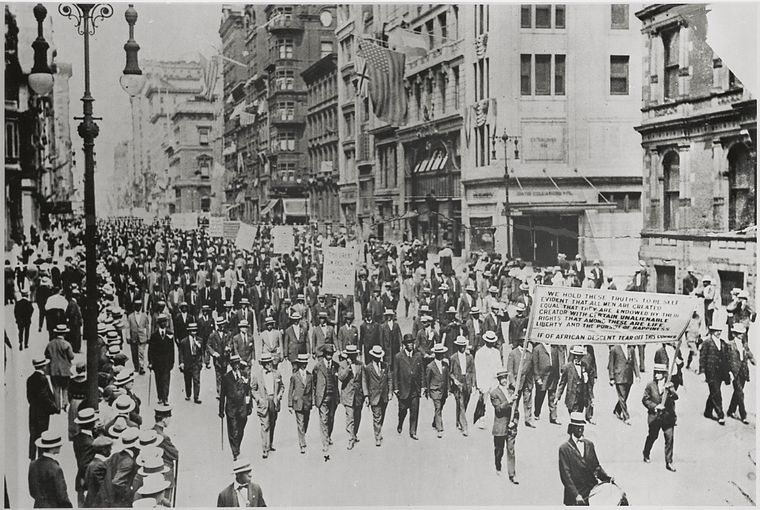Teaching Anti-Racism: Digital Resources About Racism and Resistance
Written by Ariel Birdoff & Tiffany James, School Support
Teaching during this pandemic has been a challenge for both teachers and parents, but educating young people is critical work. The murder of George Floyd has led to global uprisings demanding justice for Black lives, requiring us all to have tough conversations about race. If you are looking to teach your students or children about the history of racism, the context for the current uprisings, and anti-racist activism—whether it be over the internet or the kitchen table—The New York Public Library offers many digital resources available with your library card.
- PRESS READER Press Reader provides access to current newspapers from around the world in a full-color, full-page format. It includes over 2,000 U.S. and international titles. Try looking up articles on George Floyd and the recent protests. Remember to check the media bias of the newspaper you're reading. Media Bias/Fact Check is a good place to start. You may want to ask your students to notice how different news sources report the same facts. How does their bias play into that?
- BIOGRAPHY IN CONTEXT This database provides biographical information on 650,000+ people from throughout history, around the world, and across all disciplines. Have your students look up a celebrity of their choice. Then have them look up Alicia Garza, Patrisse Khan-Cullors, and Opal Tometi. Who are they? What are they known for? Who has more press coverage? Why do they think that is?
- OPPOSING VIEWPOINTS Opposing Viewpoints offers material to support differing views and helps students develop critical thinking skills on thousands of current social topics in the forms of primary source documents, statistics, websites and multimedia. Look up "Black Lives Matter" and ask your students to notice how both "sides" of the movement are represented. Do they know anyone who has the "opposing viewpoint?" How can they use the information provided to convince others in a constructive way that black lives matter?
-
AFRICAN AMERICAN EXPERIENCE This resource contains full-text digital resources exploring the history and culture of African Americans, as well as the greater African Diaspora. Explore different time periods in history and note what has changed and what remains the same from the Civil Rights Movement of the 1950s and '60s to the Black Power Movement in the 1960s and '70s to our present day. Compare and contrast or go even further back to the 1800s and discuss emancipation and Jim Crow laws.
- BOOKFLIX BookFlix pairs classic fictional video storybooks from Weston Woods with nonfiction e-books from Scholastic. This is a great resource for simultaneous use e-books geared toward children. It includes biographies about notable African Americans such as Jackie Robinson, Ruby Bridges, and Harriet Tubman. For older learners, you can have them read the following article by Dr. Rudine Sims Bishop "Mirrors, Windows, and Sliding Glass Doors" and then ask them to see how many mirror or window books they see . What does this say about representation?
- FREEDOMFLIX FreedomFlix brings history to life by capturing dramatic and defining moments in American history. Check out the Civil Rights resources which include lesson plans, writing prompts, project ideas, primary resources and more. Consider the suggested project idea to create a virtual Civil Rights exhibit celebrating heroes and the movements using photos, quotes, videos and other additional sources.

These resources above are perfect for young learners, but they're open and available to students of all ages with your library card. If you are looking for further reading and other resources, please check our book list and our Racial Literacy Resource list:
- The Schomburg Center's Black Liberation Reading List
- Race, Racism, and Revolution Reading List for Educators
- Discussion Questions for Race, Racism, and Revolution Reading List for Educators
Lastly, we can't forget about mental and emotional health during this time. Speaking out and protesting against racism and white supremacy is important, but can be draining. As we are having more and more discussions about such topics, one way to help students express their thoughts and feelings could be through journaling. NYPL's Digital Collections as well as Facing History And Ourselves Educator Resources could aid in this.
Our Digital Collections include examples of letters and diaries as well as many other primary sources for inspiration. For example, here is a draft of an open letter to Angela Davis from James Baldwin written in 1971. Your students could write their own letters to an activist they look up to like the character Justyce did in Dear Martin which is on our Race, Racism, and Revolution reading list. (The sequel, Dear Justyce, will be out in September 2020.)
The resources at Facing History and Ourselves include writing prompts, questions for discussion, and guidance for educators to talk with students about our world's current state of events.
How are you teaching/embodying anti-racism? Share with us below!
If you don’t have an NYPL library card, New York State residents can apply for a digital card through the Library’s SimplyE app (available on the App Store or Google Play). Once you’ve received your barcode and PIN, explore SimplyE to discover hundreds of thousands of e-books, plus visit our website to find many more digital resources
Read E-Books with SimplyE
 With your library card, it's easier than ever to choose from more than 300,000 e-books on SimplyE, The New York Public Library's free e-reader app. Gain access to digital resources for all ages, including e-books, audiobooks, databases, and more.
With your library card, it's easier than ever to choose from more than 300,000 e-books on SimplyE, The New York Public Library's free e-reader app. Gain access to digital resources for all ages, including e-books, audiobooks, databases, and more.
If you don’t have an NYPL library card, New York State residents can apply for a digital card online or through SimplyE (available on the App Store or Google Play).
Need more help? Read our guide to using SimplyE.
